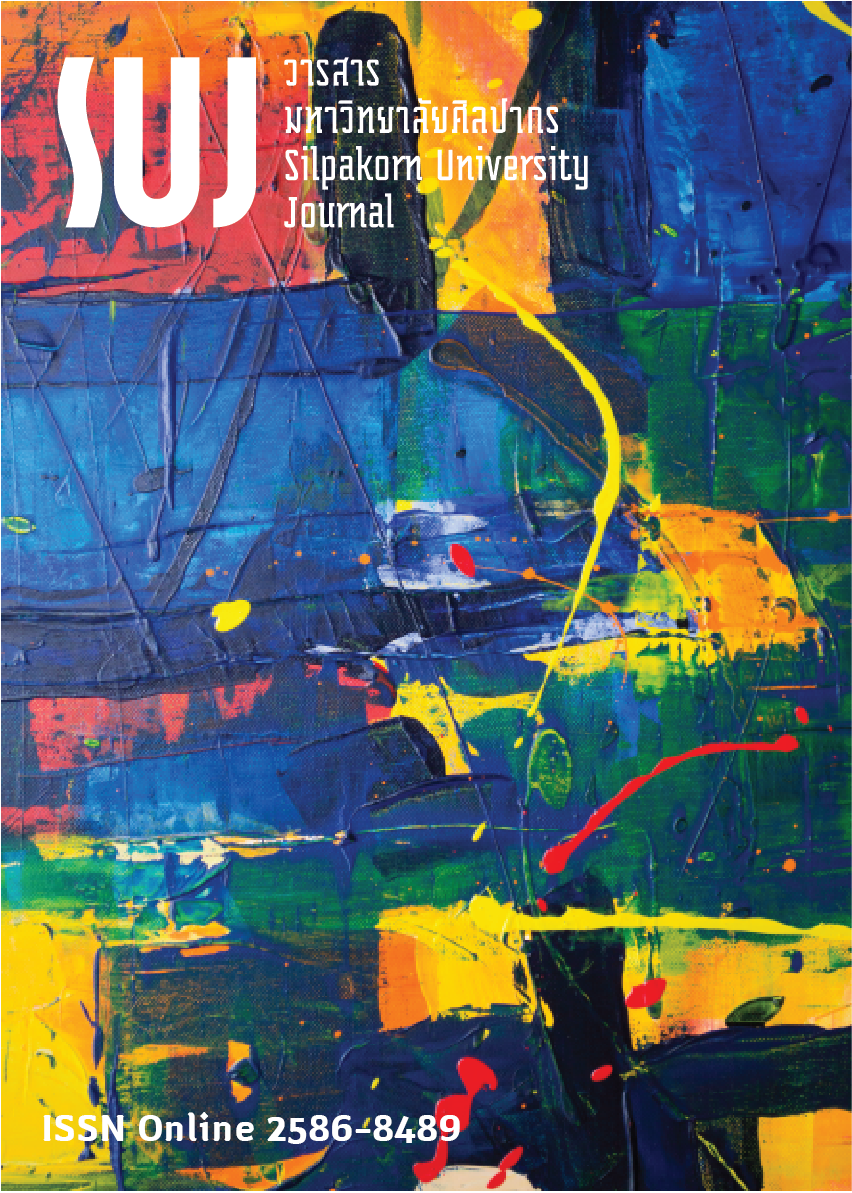การสร้างสรรค์นาฏศิลป์ไทยร่วมสมัย : วัฏสงสาร (The creation of Thai contemporary dance: Round of Existences)
Main Article Content
Abstract
วิจัยฉบับนี้มีวัตถุประสงค์เพื่อสร้างสรรค์ผลงานนาฏศิลป์ไทยร่วมสมัย ชุดวัฏสงสาร และเพื่อศึกษาการสร้างสรรค์ผลงานนาฏศิลป์ภายใต้แนวคิดพุทธศาสนา โดยเป็นงานวิจัยสร้างสรรค์และวิจัยเชิงคุณภาพ ซึ่งใช้แนวคิดหลักธรรมพุทธศาสนาทางด้านวัฏสงสาร สัญญะวิทยา และทฤษฎีทางศิลปกรรมศาสตร์ (นาฏศิลป์ ดนตรี และทัศนศิลป์) โดยมีวิธีดำเนินการวิจัยเริ่มจากการเก็บรวบรวมข้อมูล การเก็บข้อมูลภาคสนาม การสัมภาษณ์ ซึ่งนำไปสู่การตรวจสอบข้อมูล การวิเคราะห์ และการสร้างสรรค์การแสดง
ผลการวิจัยพบว่า ผู้วิจัยสามารถสร้างสรรค์การแสดงนาฏศิลป์ไทยร่วมสมัย : วัฏสงสาร ได้อย่างบรรลุวัตถุประสงค์ โดยมีองค์ประกอบในการสร้างสรรค์การแสดงรวม 6 องค์ประกอบคือ 1. บทการแสดง สร้างสรรค์ขึ้นภายใต้แนวคิดวัฏสงสาร ประกอบด้วย 3 ช่วงการแสดงคือ กำเนิด ดำรงอยู่ และสิ้นสุด 2. นักแสดง มีความสามารถทางด้านนาฏศิลป์และการสื่อสารอารมณ์ 3. เพลง เป็นการผสมผสานดนตรีไทยและดนตรีตะวันตก และมีการใช้เสียงสังเคราะห์ (Synthesizer) 4. เครื่องแต่งกาย ตีความรูปแบบและสีตามกรอบทฤษฎีสัญญะวิทยา 5. อุปกรณ์การแสดง ใช้เครื่องประดับศีรษะและผ้าพันร่างกาย โดยตีความตามกรอบทฤษฎีสัญญะวิทยา 6. ท่า การแปรแถว และการออกแบบพื้นที่ เป็นการใช้ท่านาฏศิลป์ไทย นาฏศิลป์ร่วมสมัย และท่าชีวิตประจำวัน และใช้การแปรแถวโดยคำนึงพื้นที่เวที 9 ส่วนตามเวทีแบบโพรซีเนียม (Proscenium) นอกจากนี้ผู้วิจัยได้ทำแบบสอบถามในประเด็นการสร้างสรรค์ผลงานนาฏศิลป์ภายใต้แนวคิดพุทธศาสนา โดยนำเสนอการแสดงออกเผยแพร่สู่สาธารณชนในงานมหกรรมศิลปะและวัฒนธรรมนานาชาติ (International Festival of Arts and Culture 2018) ณ มหาวิทยาลัยศรีนครินทรวิโรฒ โดยได้รับผลการทำแบบสอบถามทั้งสิ้น 155 คน สามารถสรุปได้ว่า หลักธรรมคำสอนทางพุทธศาสนาสามารถนำมาถ่ายทอดในรูปแบบการแสดงนาฏศิลป์ได้ และส่งผลให้ผู้ชมการแสดงเกิดความเข้าใจในการสื่อสารแสดง รวมทั้งยังได้รับแง่คิดจากการแสดงสร้างสรรค์ชุดนี้
The purposes of this research are to create Thai contemporary dance entitled “Round of Existences”and to explore the creation of Thai dance based on Buddhist concepts. This creative and qualitative research is based on the concepts of Buddhism in terms of round of existences and semiology, as well as the theory and practice of fine and applied arts (dance, music, and visual arts). The research methodologies included data collection from documents, field survey, and interviews. Such data was then analyzed to create the performance.
It was found that the researcher could create Thai contemporary dance entitled “Round of Existences”. The composition of the dance was divided into six parts comprised 1) the creation of the performance script under the concept of round of existences which was divided into three parts: birth, life, and death, 2) skilled performers with abilities to perform Thai dance and convey emotions, 3) music for performance which was the mixture of Thai and Western music and also with the use of synthesizer, 4) the patterns and colors of the costume under the concept of semiology, 5) props and performance crafts including headdresses and fabric wrapped around the body, based on the concept of semiology, and 6) performers’ movements, performance patterns, and performance area on the stage based on Thai dance, contemporary dance, and everyday movements. Space design on the stage was divided into nine parts according to the layout of a proscenium stage. This performance was first performed at International Festival of Arts and Culture 2018 held in Srinakharinwirot University. In addition, the researcher designed a questionnaire survey related to the creation of Thai dance based on Buddhist concepts and then distributed to the audience. The results of the questionnaire survey obtained from 155 people revealed that Buddhism doctrine could be conveyed in the form of dance performance enabling the audience to understand the concept of the performance that taught them valuable life lessons.
Article Details
References
Aphaiwong, Tridao. (2015). Acting (การแสดง). (4th ed.). Bangkok: Chulalongkorn University Printing House.
Chantanasaro, Dhrakorn. (2014). The Dance from concept of Trilaksana In Buddhism (การแสดงสร้างสรรค์ นาฏยศิลป์จากแนวคิดไตรลักษณ์ในพระพุทธศาสนา). Doctoral dissertation, Chulalongkorn University, Bangkok, Thailand.
Farrer, R. (2011). The creative dancer. Journal Research in Dance Education, 15: 95-104. [Online]. Retrieved from https://www.tandfonline.com/doi/abs/10.1080/14647893.2013.786035
Komonlagoon Dance Troupe. (2010). Traiphummigata (ไตรภูมิกถา). [Online]. Retrieved September 26, 2018 from https://www.youtube.com/watch?v=tvsEL3ckKAY
Nop-Udomporn, Kittikorn. (2011). The Creation of Thai Contemporary Dance in the concept of Semiotic of Lotus in Buddhism (การแสดงสร้างสรรค์นาฏยศิลป์ไทยร่วมสมัยจากสัญญะดอกบัวในพุทธ). Doctoral dissertation, Chulalongkorn University, Bangkok, Thailand.
Phatkulpisarn, Thanaphat. (2015). The Creation of Thai Contemporary Dance in the concept of Front And Back (การแสดงสร้างสรรค์นาฏยศิลป์ไทยร่วมสมัยในแนวคิดเบื้องหน้าเบื้องหลัง). Doctoral dissertation, Chulalongkorn University, Bangkok, Thailand.
Phra Brahmagunabhorn (P. A. Payutto). (2010). A Buddhist Solution for the Twenty-first Century (พุทธวิธีแก้ปัญหาเพื่อศตวรรษที่ 21) (20th ed.). Bangkok: The Agricultural Co-operative Federation Press.
Rochelle, H. (2015). Rethinking Dance Theory Through Semiotics. Research Journal Studies about Languages, (26): 110-126. [Online]. Retrieved June 16, 2018 from https://zenodo.org/record/1118816/files/10.5755_j01.sal.0.26.12426.pdf

